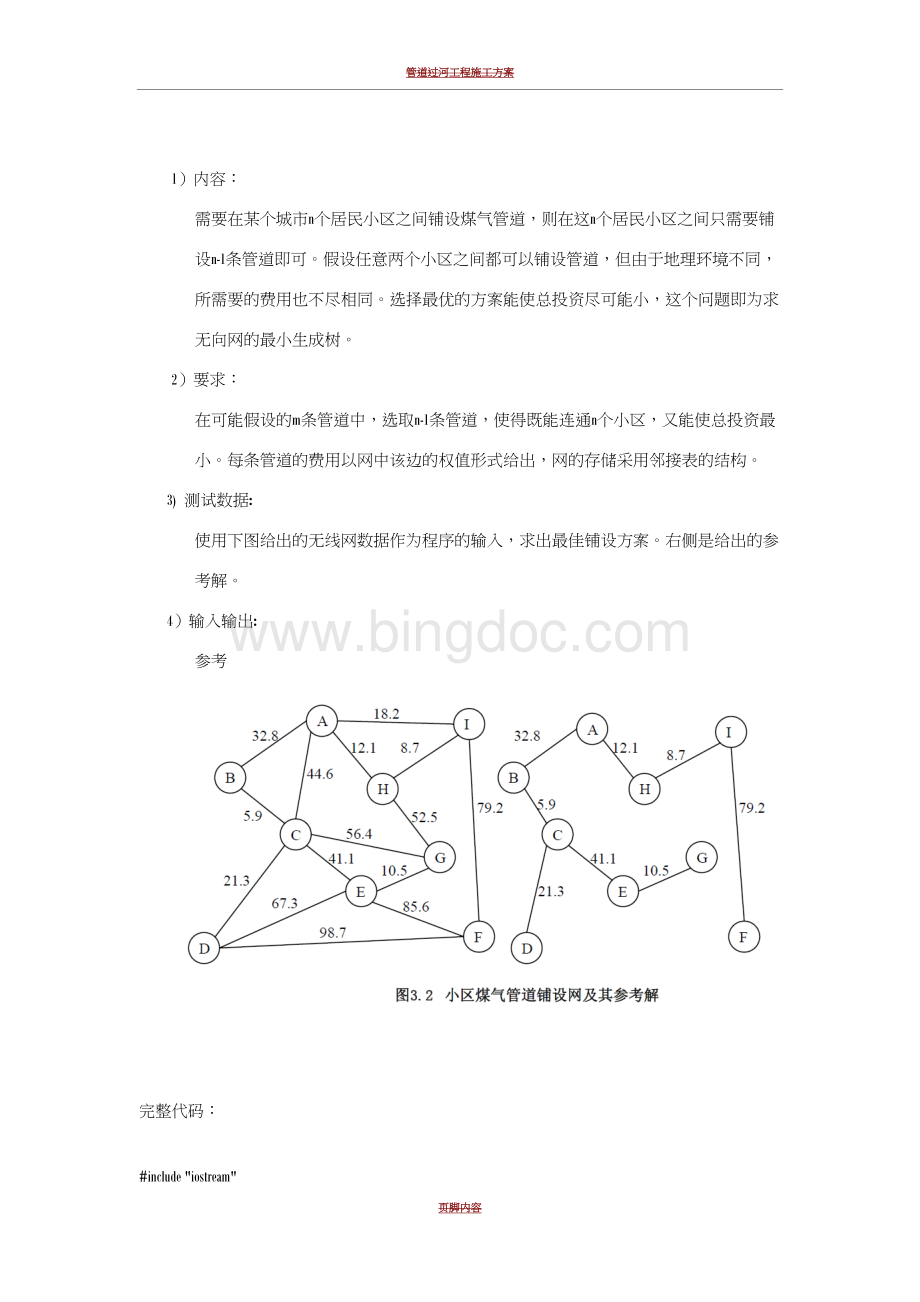管道铺设施工的最佳方案 完整程序代码.docx
《管道铺设施工的最佳方案 完整程序代码.docx》由会员分享,可在线阅读,更多相关《管道铺设施工的最佳方案 完整程序代码.docx(7页珍藏版)》请在冰点文库上搜索。

管道过河工程施工方案
1)内容:
需要在某个城市n个居民小区之间铺设煤气管道,则在这n个居民小区之间只需要铺设n-1条管道即可。
假设任意两个小区之间都可以铺设管道,但由于地理环境不同,所需要的费用也不尽相同。
选择最优的方案能使总投资尽可能小,这个问题即为求无向网的最小生成树。
2)要求:
在可能假设的m条管道中,选取n-1条管道,使得既能连通n个小区,又能使总投资最小。
每条管道的费用以网中该边的权值形式给出,网的存储采用邻接表的结构。
3)测试数据:
使用下图给出的无线网数据作为程序的输入,求出最佳铺设方案。
右侧是给出的参考解。
4)输入输出:
参考
完整代码:
#include"iostream"
#include"stdlib.h"
#defineMAX_VERTEX_NUM20
typedeffloatWeightType;
typedefstructArcNode{
intadjvex;
WeightTypeweight;
structArcNode*nextarc;
}ArcNode;
typedefstructVertexNode{
chardata;
ArcNode*firstarc;
}VertexNode,AdjList[MAX_VERTEX_NUM];
typedefstruct{
AdjListvertices;
intvexnum,arcnum;
intkind;
}ALGraph;
intLocateVex(ALGraphG,charv)
{
inti;
for(i=0;i {
if(G.vertices[i].data==v)
returni;
}
return-1;
}
voidCreateGraph(ALGraph&G)
{
inti,j,k;
charvi,vj;
WeightTypeweight;
ArcNode*p,*q;
std:
:
cout<<"请输入顶点个数,边数和图的类型:
\n";
std:
:
cin>>G.vexnum>>G.arcnum>>G.kind;
for(i=0;i {
std:
:
cout<<"请输入各个顶点:
\n";
std:
:
cin>>G.vertices[i].data;
G.vertices[i].firstarc=NULL;
}
for(k=0;k {
std:
:
cout<<"请输入两顶点和其边的权值:
\n";
std:
:
cin>>vi>>vj>>weight;
i=LocateVex(G,vi);
j=LocateVex(G,vj);
p=(ArcNode*)malloc(sizeof(ArcNode));
p->adjvex=j;
p->weight=weight;
p->nextarc=G.vertices[i].firstarc;
G.vertices[i].firstarc=p;
if(G.kind==2)
{
q=(ArcNode*)malloc(sizeof(ArcNode));
q->adjvex=i;
q->weight=p->weight;
q->nextarc=G.vertices[j].firstarc;
G.vertices[j].firstarc=q;
}
}
}
intMinEdge(WeightTypelowcost[],intvexmun)
{
inti,k;
WeightTypej;
k=0;
while(lowcost[k]==0)
{
k++;
}
j=lowcost[k];
for(i=k+1;i {
if(lowcost[i]!
=0&&lowcost[i] {
j=lowcost[i];
k=i;
}
}
returnk;
}
voidPrim(ALGraphG,intv0,intadjvex[])
{
WeightTypelowcost[MAX_VERTEX_NUM];
inti,k;
ArcNode*p;
for(i=0;i {
if(i!
=v0)
{
lowcost[i]=999;
adjvex[i]=v0;
}
}
p=G.vertices[v0].firstarc;
while(p)
{
lowcost[G,p->adjvex]=p->weight;
p=p->nextarc;
}
lowcost[v0]=0;
for(i=0;i {
k=MinEdge(lowcost,G.vexnum);
if(k>=G.vexnum)
return;
std:
:
cout<<"("< lowcost[k]=0;
p=G.vertices[k].firstarc;
while(p)
{
if(p->weightadjvex])
{
adjvex[p->adjvex]=k;
lowcost[p->adjvex]=p->weight;
}
p=p->nextarc;
}
}
}
intmain()
{
intadjvex[MAX_VERTEX_NUM];
ALGraphG;
G.kind=2;
CreateGraph(G);
Prim(G,0,adjvex);
return0;
}
/*测试数据
9152
A
B
C
D
E
F
G
H
I
AB32.8
AI18.2
AH12.1
AC44.6
BC5.9
CD21.3
CE41.1
CG56.4
DE67.3
DF98.7
EF85.6
EG10.5
HG52.5
IH8.7
IF79.2
*/
页脚内容